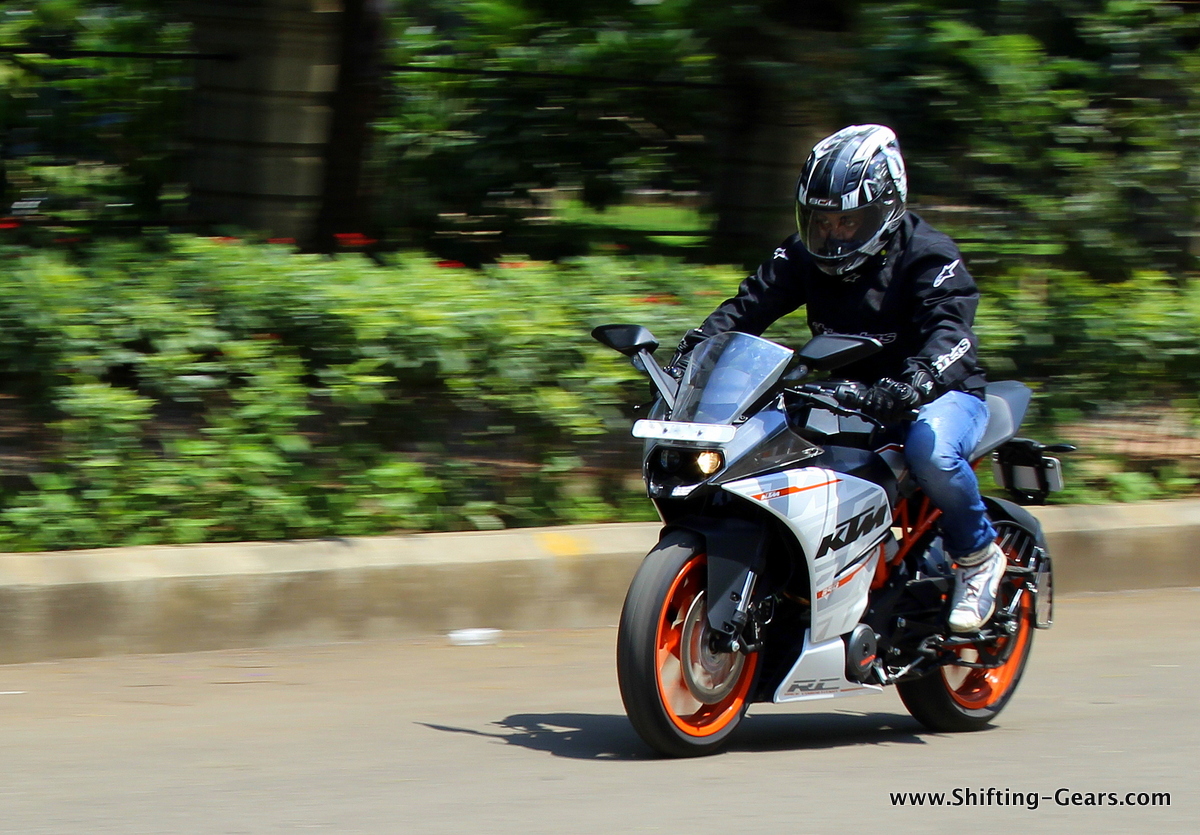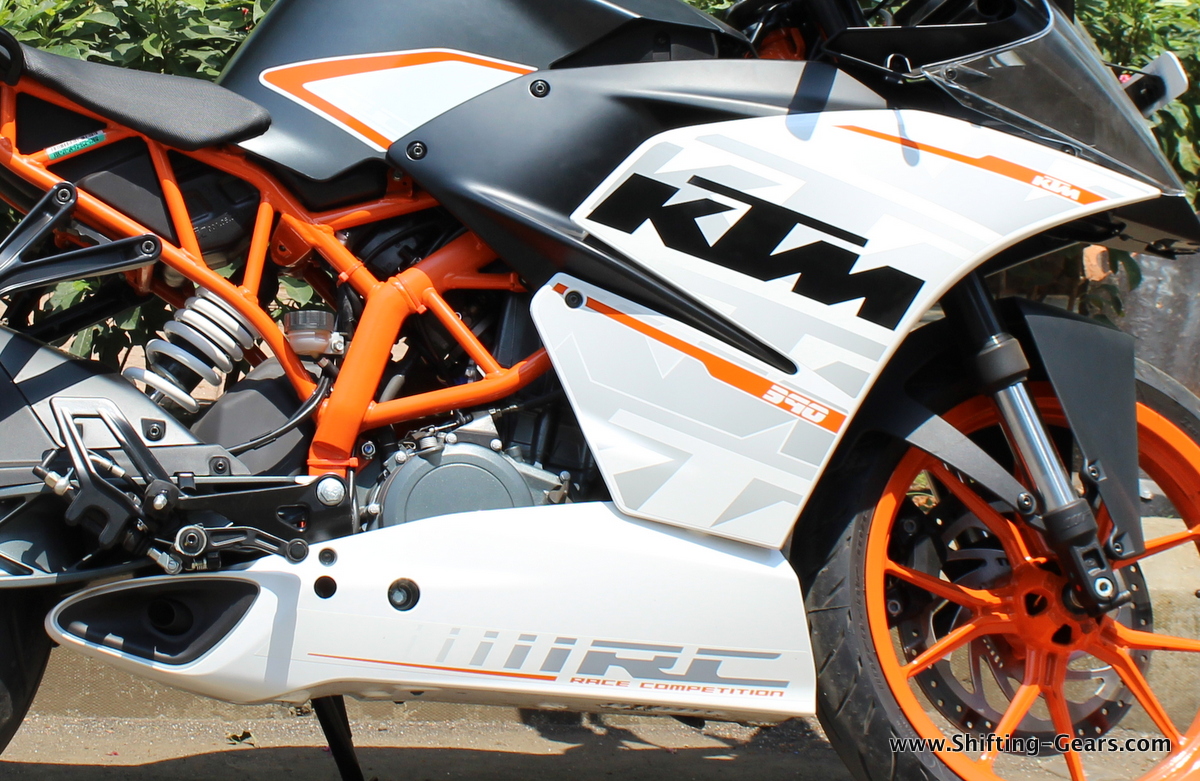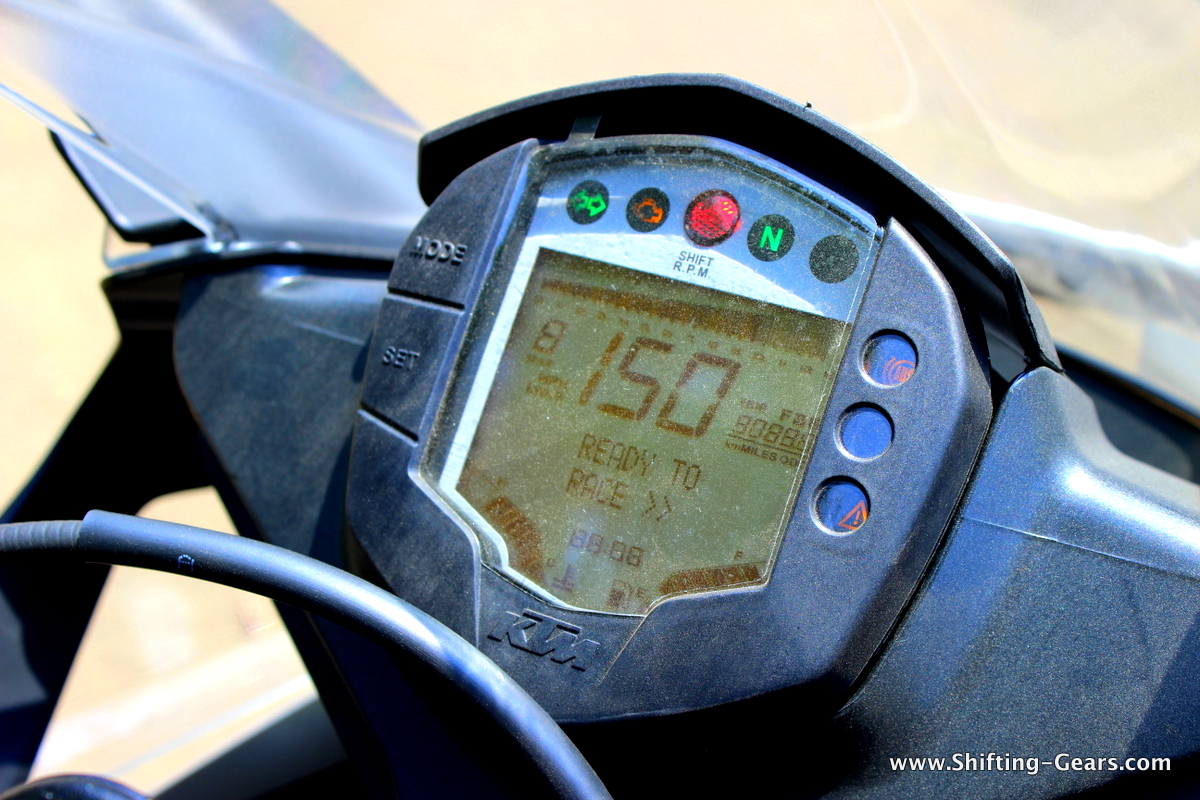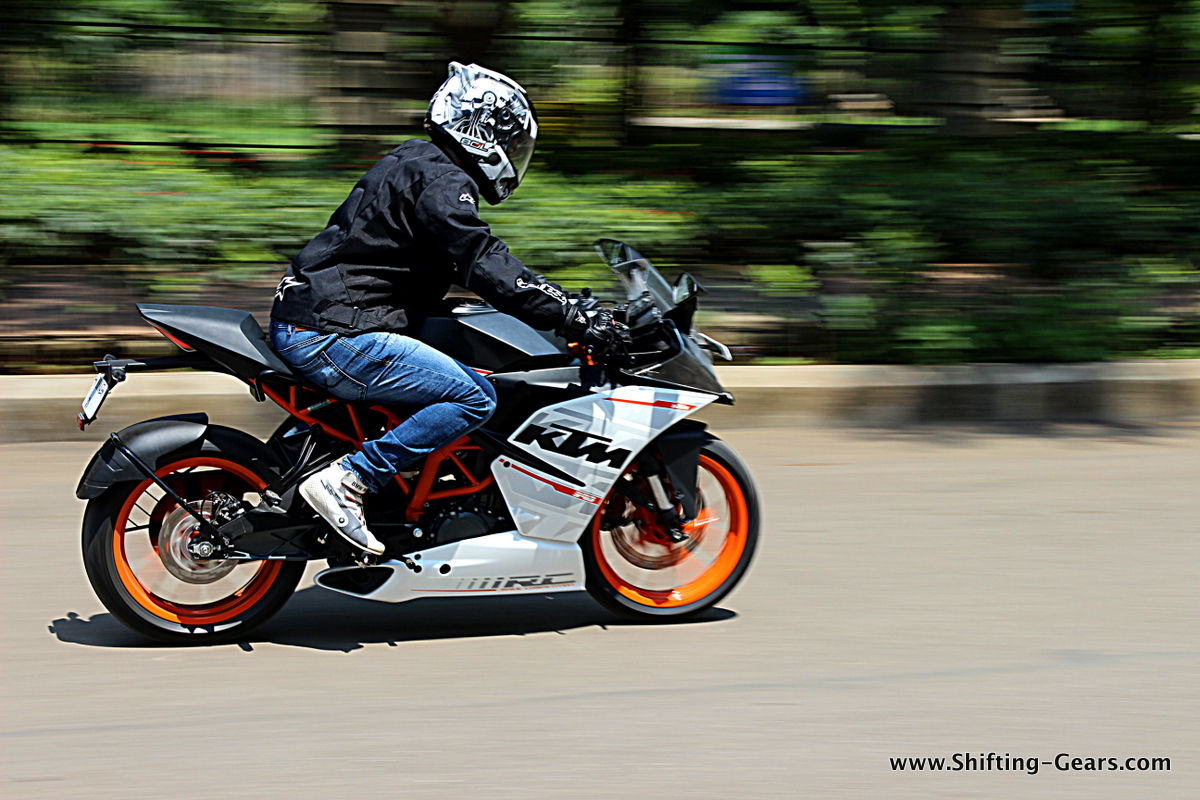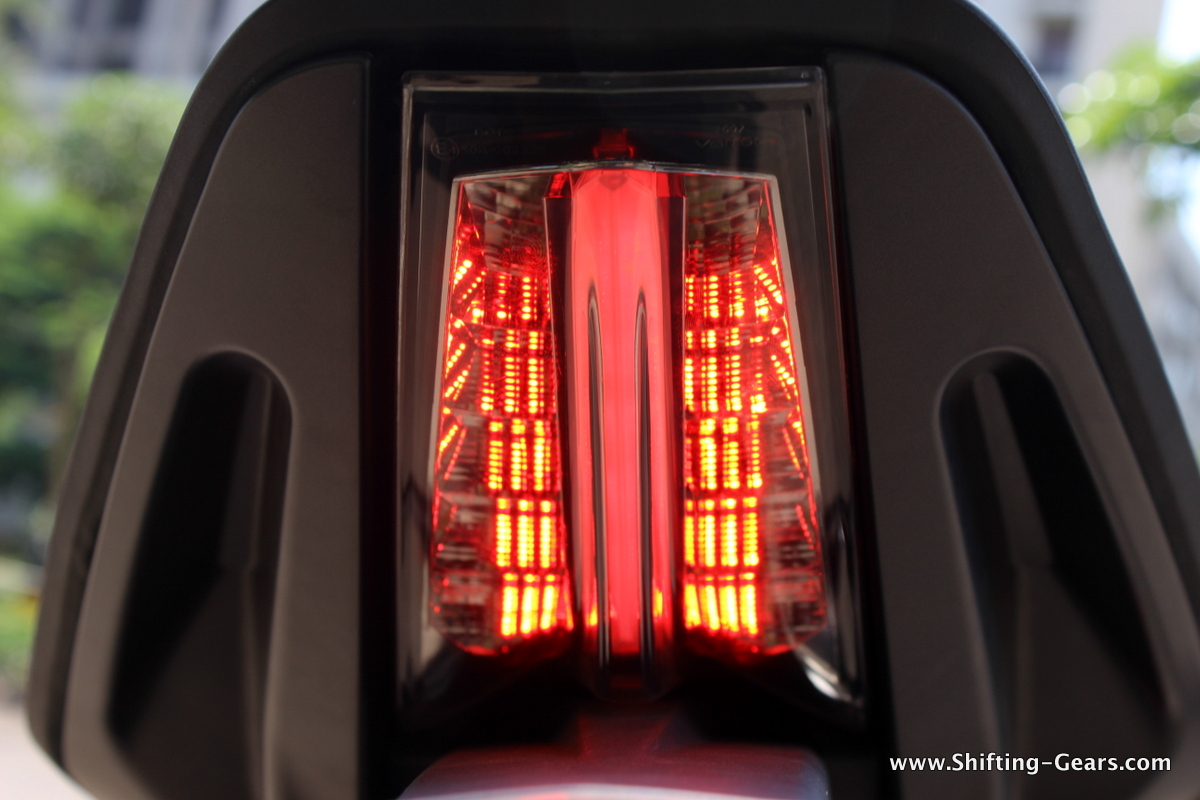Bajaj had revealed in 2008 that they would jointly develop new 125cc and 200cc motorcycles for the European markets and will badge them as KTM products. Following suit, in January 2012, Bajaj launched the KTM Duke 200 in India. The Duke 200 which is made in India at Bajaj Auto’s facility at Chakan near Pune is sold globally. It was a big step up for Bajaj as well with technical expertise trickling down to their bread and butter Pulsar range of motorcycles. Bajaj also made the Duke 125 in India, but was only exported and not sold over here. This was because the engine capacity to price ratio would not have driven in as much sales as the brand would expect. Later in 2013, Bajaj and KTM launched the Duke 390. With unmatched power, packed with features including ABS and at an unbeatable price; the KTM Duke 390 was an instant hit and enthusiasts were happy to have such an affordable performance motorcycle in the market. But it wasn’t that easy to capture the market. The Duke 390 which will work seamlessly in European markets due to more favourable weather conditions and better infrastructure, had a few niggles to be ironed out for the Indian sector. Initial lot of bikes faced issues such as overheating, radiator not functioning, cracking of wheel rims on bad roads etc. which were not justified for a asking price of Rs. 2 lakh. But Bajaj and KTM slowly ironed these issues out. Also, with the amount of performance on tap, owners were not too vocal about the problems given that the sheer acceleration that the Duke 390 offered overshadowed the niggles. But the Duke 390 was more suited for touring with it’s upright seating position. It could roam around the twisties, but carving corners wasn’t an easy task. And those who crave for corner carving machines are in big numbers. People want and love faired motorcycles. Some love it for form, while some love it for function. Whatever is the case, a track spec motorcycle is always more fun to flick around and get that knee down. This is when the RC series came into the picture.
Sighting big market demand for track tools, Bajaj and KTM decided to enter in the supersport category in India. With the Duke range already on sale, the company had a heart (engine) which was ready for the tracks, but didn’t have the body to do so. At the 2013 EICMA motorcycle show in Italy, KTM revealed the RC390, Rc200 and RC125 to the market. Ever since that unveil, fanboys in India knew it for sure that these motorcycles would first make it to India since the global production hub is located in Pune. After months of testing, the bikes were finally launched in the month of September 2014 at a very attractive price of Rs. 1.60 lakh for the RC200 (ex-showroom Delhi) and Rs. 2.05 lakh for the RC390 (ex-showroom Delhi). The bikes are currently available for sale and can be booked for an amount of Rs. 30,000. Within a couple of days after the launch, KTM showrooms all over the country have been packed with younger crop willing to have a shot at the faired KTM siblings. The bikes looked sharper and different compared to arch rivals, offering better differentiation. Considering high levels of interest and enthusiasm, we took the RC390 and put it through the paces, and this is what we have to say…
Design:
With the biking culture and weekend bike rides becoming the in-thing off late, more and more motorcyclists and the younger blood have resorted to faired motorcycles for their design language. No matter the engine is just 150cc or 250cc, the faired version for a few is what makes the bike ‘look’ fast. And for those, and for others who know their machines, KTM offers the best money can buy for under Rs. 2.5 lakh on-road. The RC390 is based on the Duke 390, but both of them look worlds apart. The RC gets sharper supersport styling cues from the bigger RC8 sibling.
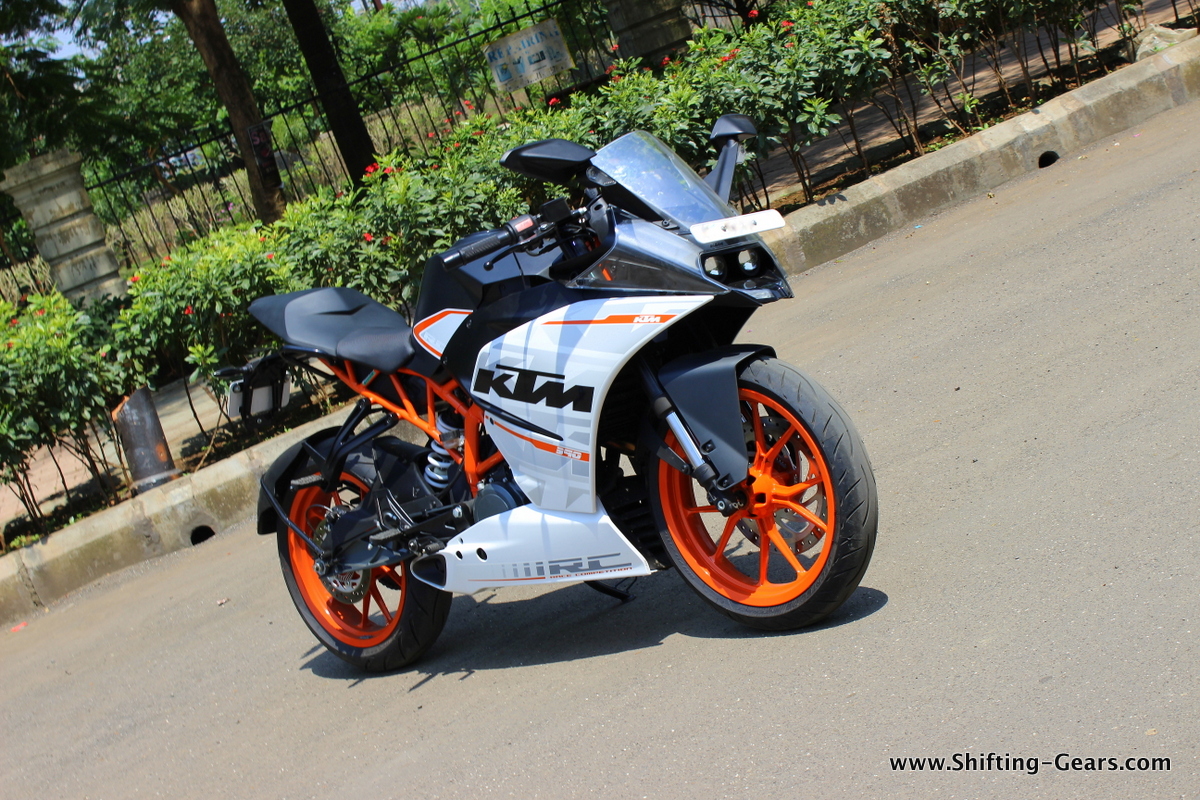
The design is fresh, although, it won’t please all. It might come out as too sharp for some, while others might simply love it at first sight.
At the front, you have a pointy, sharp front fairing with the nose protruding out. The overall design of the fairing at the front tapers down towards the bottom. You get segment first dual projector headlamps and two LED DRLs below. The headlamp setup is unique and does not have a lens over the projectors. Both the projectors and the LED DRLs (Daytime Running Lights) are exposed and hence, cleaning them is a must. Also, in case of a front impact, you cannot get away with just replacing the clear lens on top, because it just does not exist on the RC390. Fairing setup is unique. It gets grey colour plastic panels underneath and a layer of plastic cowl over, which also includes a front windshield. This looks fantastic and will surely result in better aero performance with the sharp design. But, there is a significant gap between the grey plastic and the clear lens. Problem – DUST. Keeping the front end clean will be a task and you will have to resort to pressure (pipe) washing because you hands will simply not reach each and every corner. Another segment first and unique feature are the turn indicators mounted on the rear view mirrors. But be careful in traffic conditions, if something gives a blow on the mirrors, these things are prone to damage. Rear view mirrors are sharply designed and the mirror stalks are flat too. KTM has put in a lot of effort to increase the aero-performance on the RC series considering that it does gain a few kilos over the Duke siblings. Front mudguard is a little quirky to look at and ends before the LED DRL section. It is short and placing your number plate over here as a sticker will do no good, cops will find it unacceptable due to poor visibility.
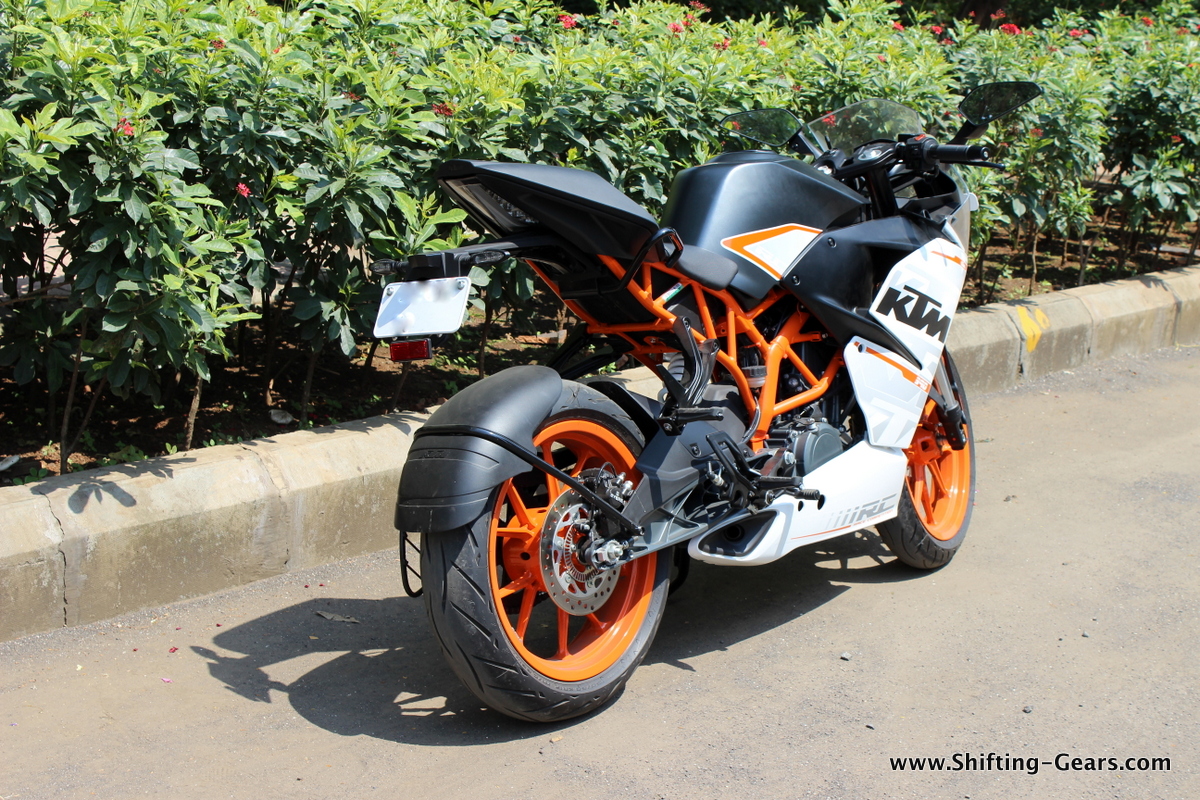
Apart from cosmetic changes, KTM has also revised the trellis frame and claim that it is stiffer on the RC
You don’t have to look at the KTM logo on the fairing from the side, the exposed orange trellis frame shouts out to be a KTM product. The RC390 comes with only a single colour option, which is a white side fairing while the RC200 gets a black unit. KTM will soon come up with a decal kit for both the bikes under their powerparts section and will cost approximately Rs. 15,000. The side fairing is pointing towards the front and gets distinct crease lines. It also has a small black section which bolts on close to the petrol tank. Among faired motorcycles, the RC390 is the best example of how an exhaust pipe should be accommodated. The underbelly exhaust is so neatly covered up, as if it is making an appearance on the RC series first and will later go to the Dukes. Does not look like an afterthought at all. Fuel tank is made of matte-black fibre and gets small decals. With the trellis frame being reworked to rise higher than the Duke, the battery had to be relocated. It is now placed ahead of the fuel filler cap. The cover to reveal the battery is very delicate and will break easily if too much force is applied. Rear set foot pegs get black powder-coated mounts for the rider and also for the pillion. Seat is of the split and step-up category. KTM has designed the pillion seat to resemble a black cowl. A lot of people came to us asking if this was a single seater and we had to demonstrate by poking the seat that it was soft enough.
At the back, you get LED tail lamps. When just the headlamp is on, there is a single LED strip in the centre which illuminates. But with the brakes pressed, you have either sides of this LED strip illuminate much brighter. The tail lamp is bright and looks fantastic at night. No doubt that the RC390 is a looker and people are attracted to it. The number plate holder is bolted on under the tail lamp and is long. Viewed sideways, the tail lamp ends way before the rear tyre. So in case someone rear ends you in bumper to bumper traffic, that big 150mm section tyre will save your LED tail lamps. Turn indicators at the back are LEDs. A common spoiler in terms of looks off late has been the tyre hugger. The RC390 gets the same tyre hugger we see on the Dukes. Yes, it is functional, but with respect to looks… naah. It also gets a small saree guard section on the LHS.
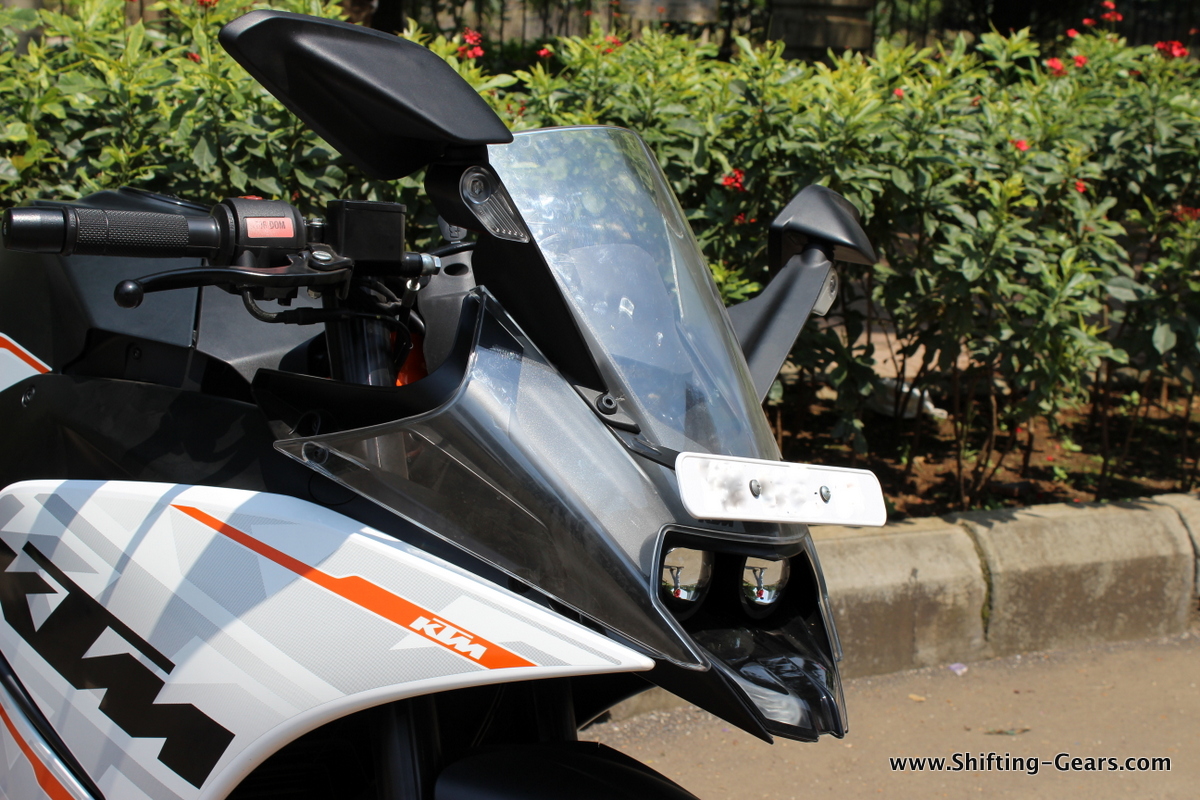
Front fairing is something different than what we’ve been seeing. It has a grey plastic body work inside, and a transparent plastic fairing on top.
Another design highlight which probably doesn’t need any mention – Orange wheel rims. KTM confirmed that the alloy wheels have now been strengthened to address the rim cracking issues being reported by the Duke owners.
Instrumentation and ergonomics:
The RC390 carries forward the same digital instrument cluster which is doing the duty on the Dukes. Yes, we would have loved something different, or say an analogue tachometer, but this is not bad either. The instrument cluster is loaded with information for the rider. It displays digital fuel and temperature gauge, time, digital tachometer, digital speedometer, DTE, average fuel efficiency, instantaneous fuel efficiency, shift light, tell-tale lights and a feature to disengage the ABS. No other bike this side of 5 lakh offers you riding information to this extent (apart from KTM). Switchgear is identical to the Duke and the quality of plastics used is acceptable. ORVMs are wide, but are placed a little low. Turning them up also didn’t do much justice with the viewing angle. Also, your elbows cover up a decent amount of the rear view mirrors. Handlebar gets bar-end weights, the RC200 doesn’t.
The RC390 has a committed riding posture, thanks to the clip-on handlebars which sit lower than the regular single piece. Also, on the RC, the steering angle is of 23.5 degree rake as opposed to 25 degree rake on the duke, which also results in shorter wheelbase. Rider has to lean a significant amount to the front and the weight is on your wrists. If you are new to such riding postures, the early months of ownerships will leave your wrists a little sore. Forged, rear set foot pegs also add to the sporty riding position. The rider seat however is rather small. Those on the heavier side will have complaints and also, it lacks padding. For the pillion, the seat which looks like a cowl is softer than it appears. It is much better in cushioning compared to the pillion seat of Yamaha R15. Pillion has two grab spots on either side of the tail lamp, under the pillion seat, to hold on for assurance when the rider is in an enthusiastic mood. Also, a very thoughtful addition on the RC series is a grab rail between the rider and pillion seat on the RHS. This not only allows the pillion to stay assured, but also keeps his weight front biased.
Engine, performance and handling:
The RC390 continues with the same Duke 390 engine without any change. it is a straight lift, although we found refinement levels a bit better. Engine is a single-cylinder, 4-stroke, water-cooled, 373.2cc petrol unit producing 43 BHP of power @ 9,000 RPM and 35 Nm of torque @ 7,000 RPM mated to a 6-speed gearbox. Changes on the technical side include a revised intake tract to the airbox and changes to the dynamo which need more power for the projector headlamps and LED DRLs.
The chassis is now stiffer on the RC390 compared to the Duke and also, as we mentioned, the change in steering angle results in a shorter wheelbase. Also, the ground clearance has increased by 8.5mm, which has resulted in higher centre of gravity and hence – easy to flick around on the track. Seat height also has gone up to 820mm, which is 20mm+ compared to the Duke. Front suspension travel has been reduced by 25mm to 125mm to provide a stiffer and track focused handling. With all the changes and wearing faired clothes, the RC has its weight gone up by 8 kg, but the aero-performance will more than make up for it.
Fire up the RC390 and you hear the familiar clatter. The engine just like on the Duke, is far from being silent. Even at idle, you feel vibrations on the foot pegs and the refinement levels are nowhere close to what the Japanese competitors can offer. It was definitely better than the Duke though, which might be a result of the stiffer chassis and well bolted forged foot pegs. Slot it in first and wring the throttle… and you are willing to negate all the small issues which might annoy you in the beginning. Just like the Duke, the RC390 has a punchy acceleration and the shift light suggesting you to stay in that power band. Acceleration from 0 kmph is definitely segment best and can achieve 100 kmph under 6 seconds. Scooting around in the city will need a lot of gear changes. Torque delivery in the lower revv range isn’t adequate and one must downshift. Also, it is not a pleasant or seamless experience riding the RC in the city with all the vibrations your feet feel. Only when you’re on the highway, the bike gets into the character and the strong acceleration almost doesn’t allow you to focus on anything else. With the fairing and the wind deflector at the front, wind blast on the rider is well controlled and reduces drag. Apart from reducing wind blast on the rider, the fairing has a lot of elements which reveal directing more air on the engine. Look behind the front wheel and you will know what we are talking about. The aero-fins on the belly and the radiator cap direct the wind on the engine, to help it stay cooler. If the Duke 390 had a hard time staying cool with all the air gushing on to it, imagine how hot the RC390 gets. The temperature bar is almost full at all times. In city traffic, it was just one bar below the full mark and we were grateful that the bike did not stall anywhere. Heat however is not felt on the riders foot unless at a standstill. Channeling of heat on the RC390 is miles ahead of the Duke 390 and is not uncomfortable at all. Among all other changes, one downer is the fuel tank capacity, which has gone down by 1 litre to 10 litres inclusive of reserve.
Gearing is tall and riders can have fun accelerating, but only at the expense of city commuting. High speed cruising is effortless as the engine in top gear is happy only at those speeds. Ride and handling was not as stiff as we expected. Although the front suspension travel has reduced, moving over potholes did not send in jerks on our arms too much. Even the rear monoshock is stiff, but pliant and can perform both track and city duties effortlessly. The RC390 is a perfect track tool with allowing you to attack the corners with your knee down. Sharper steering, stiffer chassis, stiffer suspension, shorter wheelbase and a higher centre of gravity work in the favour of track days. KTM organizing orange days at the Buddh International Circuit makes all the more sense now. The bike is light and one can flick around traffic with ease. Not to forget the grippy Metzeler tyres which allow you to do that. Highway performance is more than sufficient and you will actually fall short of straight roads when enjoying the acceleration. The light weight sometimes leaves you nervous when you encounter a small bump on high speeds. The bike can get airborne easily and we recommend being easy on the throttle on roads unknown.
Brakes coupled with Metzeler tyres and ABS work well. Initial bite is lacking and the levers do feel a bit spongy, but press it hard and the bike will stop in a straight line without any fuss.
There is nothing much we can say about the Rc390 to make or break a deal. It is by far the best money can buy at less than Rs. 2.5 lakh on the road. It is all the superbike that India needs and the only one which you can probably ride full throttle. Punchy acceleration, sharp styling, ABS, features such as projectors, LED DRLs, digital instrument console etc. all have things going for the Rc390. Yes, refinement levels are not up to the mark, but hey, there is nothing better you get at this price. The RC390 makes the already overpriced Ninja 300 look all the more overpriced now with the performance and kit it offers. So if you want to have some fun, play around on the track on the weekend or simply pose with the bike, the RC390 is surely for you.

